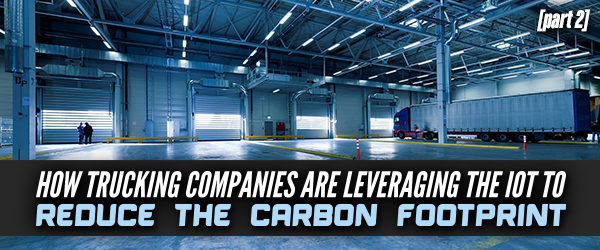
How Trucking Companies are Leveraging the IoT to Reduce the Carbon Footprint: IoT Benefits Specifically for Drivers – Part II
Recently, we discussed the leading benefits of the Internet-of-Things (IoT) and fleet management. IoT is emerging as one of the most promising and influential technologies, connecting a vast array of devices, including waste management vehicles. By using IoT, it’s possible to reduce fuel consumption by 10% or more while optimizing routes and obtaining many other benefits.
Smart cities are the future. Imagine street lights that don’t turn on according to rigid schedules, but instead weather and light conditions, usage, and other factors. Or traffic lights that can respond to changing traffic conditions, accidents, and all the rest. As for waste management, centralized coordination, smart panels, and in-depth data tracking, among other innovative features, will ultimately enhance the efficiency and effectiveness of vehicle fleets.
Let’s go over some of the more advanced and specific technologies associated with IoT and fleet management. In particular, let’s examine how IoT can have direct and tangible benefits for drivers.
Connected and Integrated Camera Systems
With IoT, it’s possible to build a web of “eyes” to view activities occurring in and around a vehicle. No matter how good the waste management driver or other team member is, humans have limited sets of eyes and limited vision. However, IoT integrated cameras can provide 365-degree viewing.
Combined with IoT enhanced smart panel displays, mobile DVR recording, and warning sensors, these cameras can help waste management team understand what’s happening around them. Such systems can help prevent accidents from happening. Should a situation arise, both the front office and driver may benefit from having the incident recorded.
Ultimately, cameras are going to be a vital component of future smart cities. Security cameras, traffic cameras, fleet cameras, so many cameras. From smart cities to waste management companies, having a constant eye on conditions is vital.
Cart & Container Management With RFID Sensors
Waste management is a complex process; with a myriad of fleet vehicles, disposal schedules, and driver routes. Trying to track all of this has been next to impossible. For this reason, many waste management operations haven’t even bothered trying. However, RFID sensors can be used to create detailed accounts of disposals and associate specific bins with addresses.
Sound complicated? In practice, it’s pretty straightforward. Handheld scanning devices can be used by drivers to scan and capture customer information, which is later compiled at the central database. This data could prove to be very valuable for billing purposes or to track events if something goes wrong. Fleet managers can also ensure that everyone’s trash is being picked up.
Further, RFID sensors allow for immense data collection. Smart cities are going to be data-driven cities, so it’s hard to overestimate how valuable data is. RFID sensors are likely going to play a big role in waste management and other areas as well.
Built-In Weight Sensors
Garbage can pile up quickly. When it comes to weight, precision is often crucial for waste management. An overloaded truck could become dangerous; an underloaded truck might be underutilized. Beyond which, understanding mass and waste flows is vital for higher level planning.
Now, smart trucks can be equipped with highly accurate, calibrated mobile scales. Each cart and container lifted can be precisely weighed, which allows both the waste management team on the ground and the central office to keep a close eye on everything.
These weight management processes can then be integrated with the onboard IoT enabled smart panels to enhance route management, order processing, and bin identification. Ultimately, these smart features will help streamline the efficiency, and organization of the entire fleet and waste management process.
Driver Direction and Monitoring
Automatic driver tools can be integrated into the onboard smart panel to provide drivers with up-to-date route information. If the driver is forced to go out of sequence for any reason, the driver direction tools will help them get back on track quickly. If a better route can be optimized, it may even be possible to change routes based on traffic and other conditions.
Should drivers be acting erratically, say idling for long periods of time, being forced to hard break, or otherwise acting out of order, the central office would be able to keep an eye on conditions. This way, the central office can keep tabs on everything.
We’re Entering an IoT Driven Future
Smart cities are the future. Soon, many of our civic devices and processes, including but not limited to waste management, will be connected to IoT. Technological capacities will allow civic leaders to make more sound decisions, and to be able to impact processes more directly.
Waste management is often thought of as “dirty” work, but with IoT, it can be smart work as well. Waste management is vital for every city and can have a considerable impact on quality of life for occupants. That’s why SYNDÉO is helping cities to lead the charge by enabling them to create space in densified areas for the secure and unobtrusive deployment of smart traffic systems under ADA curb ramps so that waste management vehicles can operate smarter and more efficient and cities can reduce the clutter and visual pollution of roadside cabinets.

